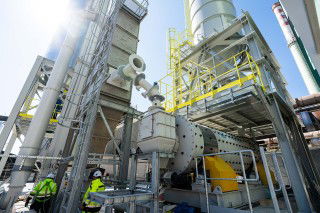This week it was announced that Attock Cement Company has launched a new 1.2Mta cement plant in Hub, just outside Karachi, while several brownfield and greenfield plants are also underway. Meanwhile, Lucky Cement has climbed its way back to the top of installed domestic capacity by completing its 1.3Mta brownfield expansion project at its Karachi plant in December. But with all this capacity expansion, will 2018 be a record year for Pakistani cement producers?
Pakistan’s cement industry is currently running at 95 per cent capacity according to the All Pakistan Cement Manufacturing Association (APCMA). This has encouraged the domestic cement manufacturers to spend an estimated US$2.25bn on new production capacity, according to the State Bank of Pakistan. Total domestic capacity is now estimated to have reached 48Mta.
What’s behind the rise in domestic cement demand?
Pakistan’s cement consumption per capita is still below the world average at 161kg, according to analysis in The Global Cement Report. Both housing and infrastructure demand are forging record demand for the cement sector. The benefits of the China-Pakistan Economic Corridor (CPEC), part of the Belt and Road initiative, is expected to have huge impact on cement production levels, with a Joint Cooperation Committee having been established to promote the construction of CPEC between 2013-30. Work has already started to make Gwadar port into a commercial and international port, and road works have begun on KKH Phase-II (Havelain-Thakot 120km) and the Karachi-Lahore Motorway (Sukkur-Multan 392km), while the energy sector is prioritising 16 projects with a total capacity of 10,400MW.
While China is pumping large amounts of investment into the country, the government has
released more than PKR318bn (US$2.87bn) under its Public Sector Development Programme (PSDP) in December and this provision included PKR2.35bn (US$21.2m) for the Housing and Works division. Construction is set to start on new housing schemes in Islamabad.
Prime Minister Shahid Khaqan Abbasi directed the Ministry of Housing last summer to submit a comprehensive plan to provide quality, low-cost housing to address the shortage of around 20,000 housing units for government employees. This will involve the restart of the PKR35bn Thaliyan Housing Scheme on the M-2 Motorway interchange, which is being organised by the Federal Government Employees Housing Foundation.
Furthermore, Prime Minister Abbasi is exploring the possibility of reviving the stalled Apna Ghar Housing scheme, a bold initiative set up to build 500,000 housing units per year.
Punjab has enough cement plants
The demand situation seems rosy, but analysts have provided mixed forecasts. The Punjab region has called a halt to any new greenfield cement plant and the industry in this part of Pakistan has been brought back under regulatory control of the provisional government after 29 years. Punjab accounts for some 81 per cent of the country’s cement capacity and has some 37Mta of capacity.
Maple Leaf Cement announced earlier this month that work on its 7300tpd capacity expansion project in Iskanderabad, Punjab, had been put on hold after receiving an order issued by the Environmental Protection Agency (EPA).
Exports still falling
Meanwhile, it has been difficult for producers to increase export sales to traditional markets such as Afghanistan, Sri Lanka, India and Africa. From July to December 2017, domestic dispatches reached 22.24Mt, up 20 per cent from 19.8Mt in the year-ago period. On the other hand, the export market has witnessed declining sales with a drop of 17.3 per cent YoY in 2H17 from the 2.91Mt recorded in 2H16.
Summary
Considering the current prospects for increased cement demand and the high utilisation rate of cement production in the country, there is a very high probability that Pakistan will produce another bumper production year in 2018. While export levels might be weaker in the short-term, ICR believes there is more than enough construction activity from public works infrastructure projects to fully occupy most local cement manufacturers in the year to come and more.

Turning waste concrete and CO2 into a binder
In July, Heidelberg Materials switched on the first continuous-mode enforced carbonation reactor...